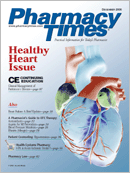Publication
Article
Pharmacy Times
Tygacil (tigecycline)
Author(s):
More than 160 million antibioticprescriptions are writteneach year in the UnitedStates. Approximately 235 millionantibiotic doses are used annually,with 20% to 50% taken unnecessarily.1Moreover, roughly 70% of bacteriacausing hospital-acquired infectionsare resistant to one or more commonlyused agents.2 The increase in bacterialresistance over the years has promptedan array of antibiotic products. Tygacil,manufactured by Wyeth PharmaceuticalsInc, has been approved for use asmonotherapy of complicated skin andskin structure infections (cSSSIs) andcomplicated intra-abdominal infections(cIAIs) in adults.3
Pharmacology
Tygacil, derived from the tetracyclinefamily, is part of a new classknown as glycylcyclines. It has activityagainst gram-positive, gram-negative,and anaerobic microorganisms, as wellas methicillin-resistant Staphylococcusaureus. Tygacil exerts its actions viainhibition of protein translation inbacteria by binding to the 30S ribosomalsubunit and blocking the entry ofamino-acyl tRNA molecules into the Asite of the ribosome.3,4
Clinical Trials
Two randomized, double-blind, multinationalstudies evaluated tigecyclinein adults for the treatment of cSSSIs.4-6Tigecycline at an initial dose of 100 mgintravenous (IV), followed by subsequentdoses of 50 mg every 12 hours,was compared with vancomycin 1 gand aztreonam 2 g every 12 hours for 5to 14 days.4 The study included patientswith a known or suspected diagnosis ofcSSSI, who were expected to require IVantibiotic therapy for at least 5 days,and who had one or more prespecifiedindicators of infection. Patients wereexcluded from the study if theyreceived more than 2 doses of nonstudyantibacterial therapy after the originalcure was obtained and before the studydrug was administered.6
The results were summarized into 2categories: the clinically evaluable (CE)and the clinically modified intent-totreat(c-mITT) populations. A favorableclinical response was observed in theNorth American trial for both the CEand the c-mITT categories, for the tigecyclineand the vancomycin-aztreonamtreatment groups, respectively.4 Favorableresponses also were observed in aglobal trial for the CE and for the cmITTcategories, respectively.4,6
In addition, tigecycline was evaluatedin patients with a cIAI. Two randomized,double-blind, active-controlled,multinational studies compared tigecyclineat an initial dose of 100 mg IV, followedby 50 mg every 12 hours, andimipenem/cilastatin at a dose of 500 mgIV every 6 hours for a total of 5 to 14days.4,7,8 Inclusion criteria comprised aknown or suspected diagnosis of cIAIand previous consideration for or a previouslaparotomy, laparoscopy, or percutaneousdrainage of an intra-abdominalabscess.8 Patients were excludedfrom participation if more than onedose of nonstudy antibacterial therapywas administered, after the original cultureand before the study drug.7
The results were divided into 2groups: those for patients who exhibiteda clinical and microbiological response(ME) and those for the microbiologicallymodified intent-to-treat(m-mITT) group. A favorable responsewas observed in the first trial in boththe ME and the m-mITT groups, withtigecycline and imipenem/cilastatin,respectively.7 In a second trial, a similarfavorable clinical response wasobserved in both the ME and the mmITTgroups, respectively.4,8
Safety
The most common adverse eventsreported with the use of tigecyclinewere nausea and vomiting. Tygacil is inpregnancy category D and is notadvised for pregnant or breast-feedingwomen. Generally, Tygacil does notrequire any renal adjustments. Patientswith severe hepatic impairment (Child-Pugh Class C), however, should receivean initial dose of 100 mg followed by25 mg every 12 hours.3,4
Outlook
Tygacil is supplied as 50-mg lyophilizedpowder for reconstitution insingle-dose 5-mL glass vials. The recommendedinitial dose is 100 mg, followedby subsequent doses of 50 mg IVadministered over 30 to 60 minutesevery 12 hours for 5 to 14 days. Tygacilappears to be a safe and favorableantimicrobial option.4
Drs. Faria and Soo are both senior researchpharmacists with the Investigational DrugService at Brigham and Women's Hospital,Boston, Mass. Dr. Faria also is a seniorhuman research specialist with PartnersHealthCare System. Nina Patel is asixth-year PharmD candidate fromNortheastern University currently onclinical clerkship in the Investigational DrugService at Brigham and Women's Hospital.
For a list of references, send astamped, self-addressed envelope to:References Department, Attn. A. Stahl,Pharmacy Times, 241 Forsgate Drive,Jamesburg, NJ 08831; or send an e-mailrequest to: [email protected].

Newsletter
Stay informed on drug updates, treatment guidelines, and pharmacy practice trends—subscribe to Pharmacy Times for weekly clinical insights.






